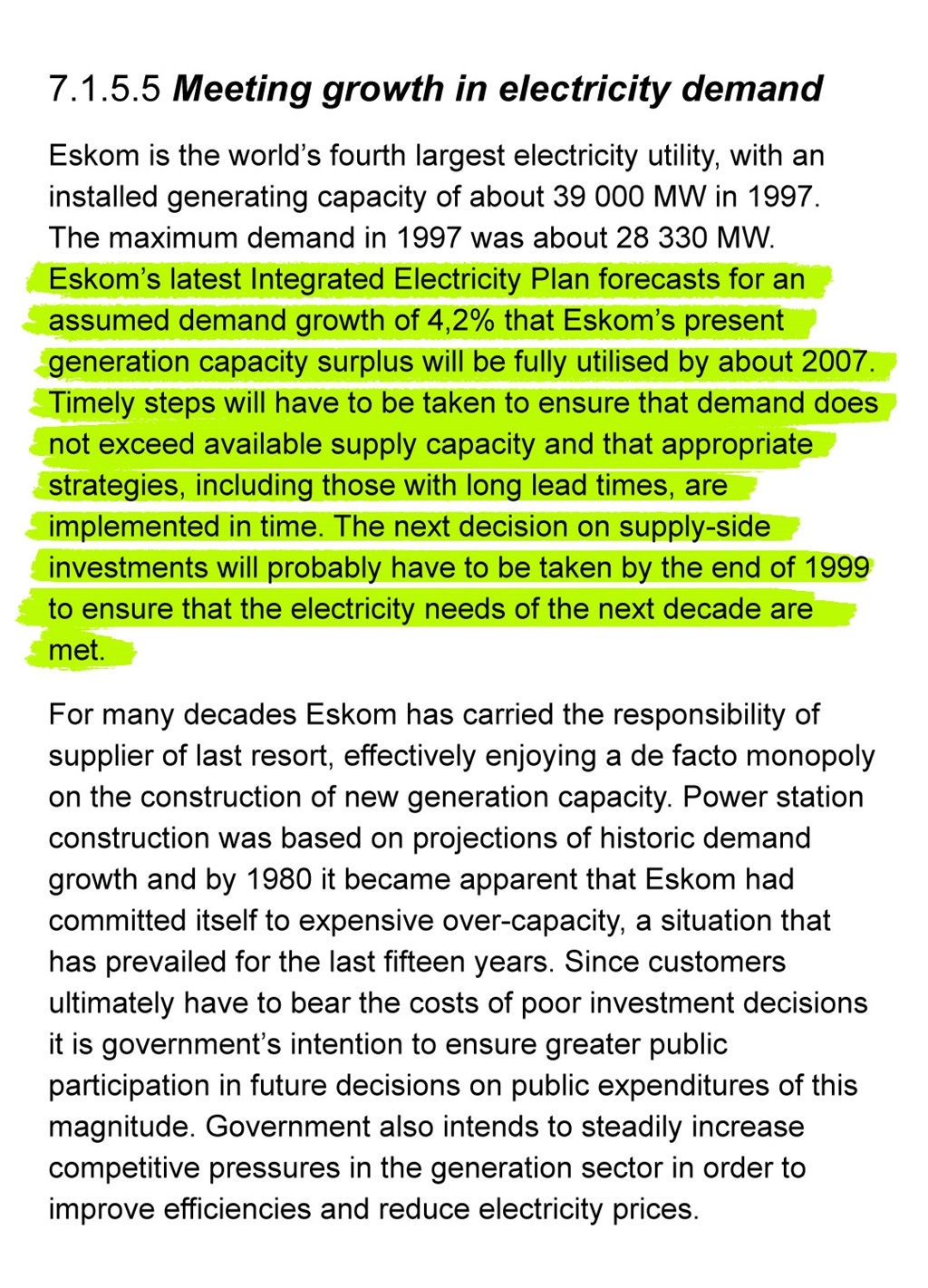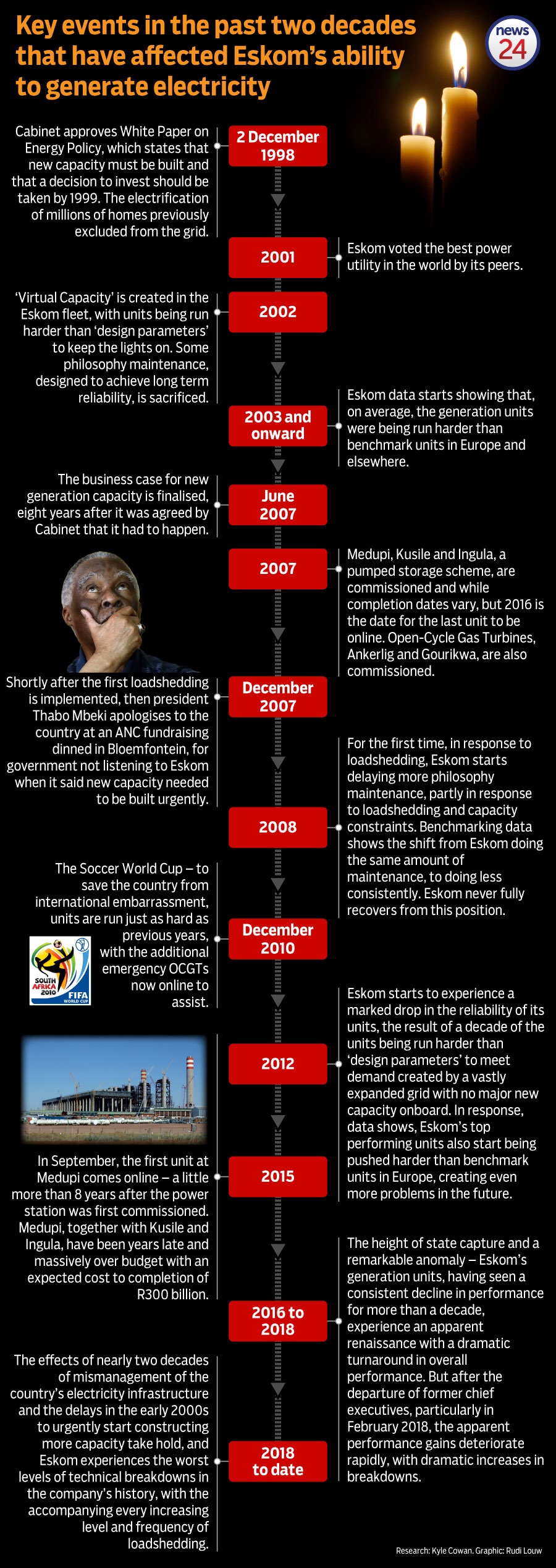Decades of decline: How Eskom fell from best in the world to national disgrace in just 20 years
- Data comparing Eskom's power stations to others around the world have revealed the scale of the mismanagement of the utility over the past 20 years.
- The country remains in the grip of load shedding as nearly 100 breakdowns at power stations create a significant shortage of electricity.
- Eskom warned the government in 1998 that more power stations were needed urgently, a warning the utility has been repeating for the past three years.
In the past 20 years, state-owned power utility Eskom has gone from being voted the best in the world in 2001 to a state of unreliability so pronounced that it is struggling on some days to meet even the lowest electricity demand of the country.
At a glitzy event in New York in December 2001, Eskom was named "Best Power Company" at the Financial Times' Global Energy Awards.
With Stage 6 load shedding implemented over the weekend and Stage 5 prevailing on Tuesday, the recent period of Eskom's worst performance in the democratic era has continued. The rotational blackouts, meant to save the national grid from collapse, are worse than ever before.
In May 2022, Eskom's chief operations officer, Jan Oberholzer, provided a grim overview for the reasons how the situation has become so dire that even a handful of breakdowns means the difference between millions of people having to contend with hours without power daily or not.
He provided three main reasons for Eskom's decline:
- There was a major delay in adding new capacity to the system, even as more homes were being connected to the grid between 1998 and 2007;
- As a result of the delay, the existing units were run much harder than was wise, causing major reliability issues down the line;
- The reliability issues were exacerbated by Eskom's liquidity problems, partly due to tariffs for electricity being lower than what it cost Eskom to actually produce the power, meaning it never had enough money to maintain the hard-working units.
Eskom estimates that it has over the years lost R380 billion, roughly the same amount as the company's massive debt, because it has never been able to charge South Africans tariffs that were cost reflective.
On paper, Eskom should have more than enough capacity to meet the country's demand – the utility owns and operates power stations with a combined capacity of 46 000 megawatts (MW), and the highest demand seen in winter months is roughly 33 000MW. In summer, this drops dramatically to around 27 000MW.
But Eskom cannot always meet this demand, due to a series of events that started in 1998, which continue to have a direct impact on Eskom to this day.
ROLLING COVERAGE | Eskom and load shedding news as it happens
On 2 December 1998, Cabinet approved a White Paper, titled "Energy Policy of the Republic of South Africa". On page 53, the paper warned that a decision on major investment to increase the country's electricity generation capacity needed to be made, or the country would run out of sufficient capacity by 2007.
At the time, the forecast was that demand would grow by approximately 4% every year. Eskom had an installed capacity of 39 000MW in 1997, with a maximum demand of 28 330MW, the paper outlined.
This means capacity has grown by around 7 000MW, and peak demand by around 5 000MW – largely due to one of the largest electrification programmes in the world, which sought to address the wrongs of the past and saw large proportions of the population excluded from the grid.
But the South African government delayed for some eight years the decision to build new capacity, setting the country on a course for future capacity problems, and load shedding which has caused massive damage to the economy as billions of rands have been bled. The potential for economic growth, if electricity supply was stable, one Eskom source explained, was near impossible to calculate.
Former president Thabo Mbeki admitted the government had got it wrong when, on 11 December 2007, at an ANC fundraising dinner, he apologised to the country in the wake of load shedding being implemented for the first time.
"When Eskom said to the government: 'We think we must invest more in terms of electricity generation', we said no, but all you will be doing is just to build excess capacity. We said not now, later. We were wrong. Eskom was right. We were wrong," an AFP report quoted Mbeki as saying.
Prophetic
Only in July 2007 was the investment decision made to procure new power generation capacity, and Medupi, Kusile and Ingula Pumped Storage were commissioned. But it was too late, Oberholzer explained.
READ | Energy crisis will get worse, analyst warns as load shedding cuts Ramaphosa trip short
"From 2002 onwards, 'virtual capacity' was created by running existing plants above normal design parameters to 'keep the lights on'. In addition, particularly since 2008, necessary philosophy maintenance was delayed to avoid load shedding caused by a lack of capacity as units would have to be taken offline for maintenance," he explained in his pr







No comments:
Post a Comment